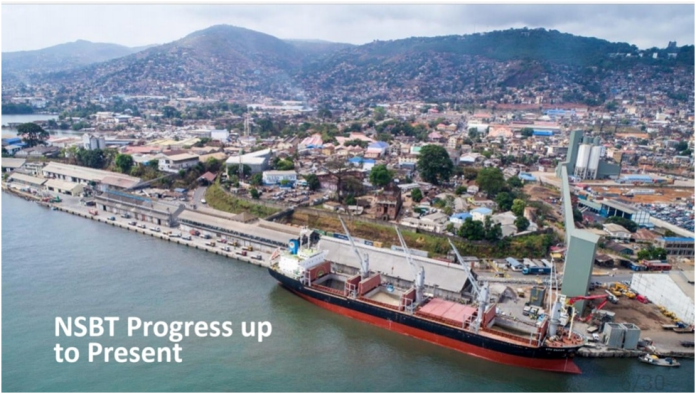By Amin Kef-Ranger
In collaboration with the Sierra Leone Ports Authority (SLPA), the National Commission for Privatization (NCP) and the Ministry of Transport and Aviation, Nectar Sierra Leone Bulk Terminal (NSBT) ,popularly known as Nectar, on the 9th June,2022 held a ground breaking ceremony at the Queen Elizabeth 11 Quay in Freetown for the construction of a new deep-water jetty with a new berth as well as to refurbish an existing berth to enable a larger class of vessel size (up to Panamax size) to call at Freetown. The cost of the Project, which is slated to be completed in 14 months, is a $35M.
The turning of the sod for the commencement of the project was done on that day by the First Lady of the Republic of Sierra Leone, Dr Fatima Bio.
The auspicious occasion was graced by the Minister of Trade and Industry, Dr Hinga Sandy, the Deputy Minister of Transport and Aviation ,Rex Bonapha, the Member of Parliament of Constituency 121, where the Project is implemented, Hon. Miniru Lansana, other high profiled personalities including the General Manager of the Sierra Leone Ports Authority (SLPA) and his Deputy, Dr Abdulai Fofana and Yakuba Askia Bio respectively, the SLPA Board Chairman , Manso Dumbuya, the Nectar Group Director, Guy Wikes, the Project Consultant, Gordon Rankine, Project Contractor, Guilbaud Laurent, a representative from the National Commission for Privatization, Saffura Rogers, Staff of NSTB, well wishers and members of the Fourth Estate.
The programme was chaired by Dr Julius Spencer and various personalities present made statements including the NSBT Group Director, Guy Wilkes, the Project Consultant, Gordon Rankine, the General Manager of Sierra Leone Ports Authority (SLPA), Dr Abdulai Fofana, the Project Contractor, Guilbaud Laurent, the Member of Parliament, Constituency 121 Hon. Miniru Lansana, the representative of the Chairman of NCP, Saffura Rogers and the Deputy Minister of Transport, Rex Bonapha.
The keynote address was delivered by the First Lady, Dr Fatima Bio.
All the speakers underscored the importance of the project and the benefits that it will bring after completion.
Key benefits highlighted after completion of the project were how it will increase the ease of shipment, make it possible for competitiveness, viability and profitability of the port facilities to come to fruition and attract greater international traffic.
Furthermore, NSBT, via the project will provide modern facilities and expand the existing berths and quayside space, increase import capacities and enable more cost-effective shipments by having deeper draft, more efficient unloading systems and a reduction in operational costs for importers and ship-owners alike.
It will make it possible to double tonnage handling in 9 years from 400,000mts (2016) to 800,000mts (2025) at QEII Berths (excluding 1.6m tons handled per annum at Nitti), put NSBT at a more vantage position to handle clinker, cement, rice, palm oil, fertilizers & wheat and further develop handling of bauxite and iron ore.
The activities and expected improvements that will follow the berth expansion include continuation by NSBT to provide services including unloading of vessels to storing of cargo in the port warehouses, as well as maintenance of all terminal equipment.
The new berth will provide additional capacity to handle more volumes as the trade grows. In addition, the backfill area will provide additional cargo handling and storage area.
The new berth will also provide 190 m berthing space (Max LOA for vessel 225m) and 13 m draft.
NSBT will continue to provide the following services: Bulk and break bulk discharge and loading, Weighbridge services, long or short term storage facilities, Quayside bagging facilities, integrated digital Terminal Management System and Consolidated Cargo Management.
The expected environmental improvements following berth expansion will include 16,000mt vessel of bulk clinker / gypsum will take on average 400 truck movements during the discharge. Currently these trucks have to travel 1.5km round trip from the factory to the berth to load and return.
The new berth will reduce that distance to 300m – thus reducing the overall distance travelled for the trucks by 80%.
That also means that discharge speeds will be increased and the environmental impact of engines running / trucks moving through the terminal will be reduced by the same amount.
It will also allow NSBT to segregate the terminal so that when handling foodstuffs like Rice / Grain on Berth 1 and 2, the more industrial type of cargoes can be kept at a distance and thus eradicate any risk of cross contamination.
The new berth will provide 225 m berthing space and 13 m draft allowing for larger vessels and economies of scale thus reducing the carbon footprint on a per shipment basis.
In addition, the new berth will allow NSBT to target a reduction in traffic (truck movements and number of trucks needed / noise and congestion for one of its major clients. Just in distance alone, it will produce a saving of 6,000kms of truck movements per annum for just 1 client in terms of distance travelled during the unloading.




